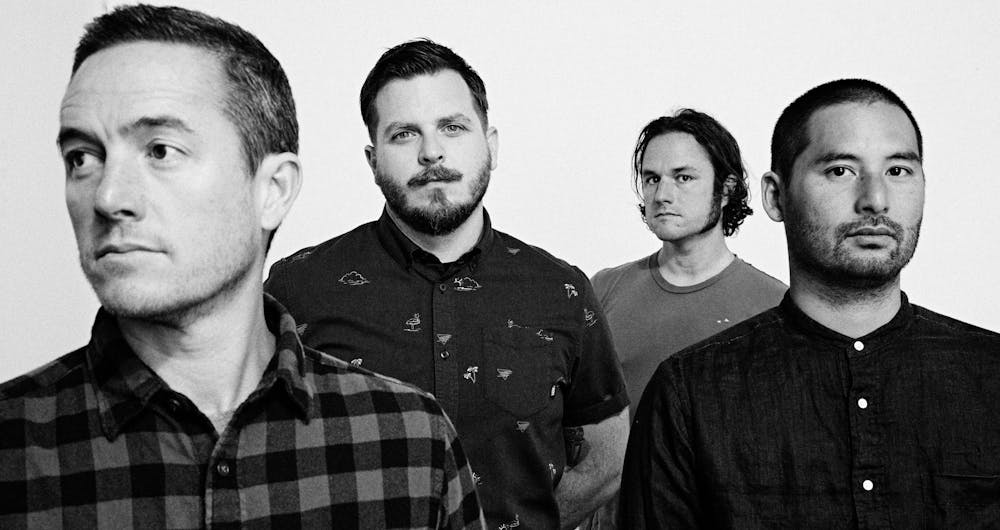Post–hardcore defies definition, even within its name. Hardcore suggests a connection to hardcore punk, but "post" implies an X–factor, something beyond its parental genre. In practice, that has meant everything from the metal screams of Dance Gavin Dance's Jon Mess to the gothic elements of AFI and the progressive concept albums of Coheed and Cambria. Orange County–based Thrice had its roots in the Southern California melodic hardcore scene, but it was the 2005 release of their album Vheissu that elevated them from a simple rock band to a titan of post–hardcore.
Vheissu experimented with the decent but forgettable punk rock sound Thrice established with previous releases The Illusion of Safety (2002) and The Artist in the Ambulance (2003). The band introduced piano and synth lines to a previously guitar–focused sound in an effort to explore "the dynamic between a really mellow part and a really heavy part," as drummer Riley Breckenridge told The Aquarian. Now, for the album's fifteenth anniversary, Thrice played Vheissu in its entirety on a nationwide tour that stopped through Franklin Music Hall on February 11.
Thrice brought along three opening acts to Franklin Music Hall, the first of which was Holy Fawn. Like many post–hardcore bands and affiliates, Holy Fawn defies simple genre categorization, but it felt as if it came from a different place than the other bands on the bill. Rather than drawing influence from hardcore and progressive rock, the band steeped in slower, more ambient genres like shoegaze and doom which earned a tepid reaction from an audience raised on faster, louder, and more lyrical musical stylings.
On a spectrum from "post" to "hardcore," Drug Church existed firmly on the opposite end of Holy Fawn. Frontman Patrick Kindlon, who is also involved with Albany rock supergroup Self Defense Family, screamed semi–coherently as the band thrashed its heavy, grungy music behind him. Kindlon famously does not write lyrics until the band begins recording in the studio, adding an additional layer of chaos to all his songs and performances.
In a different city, main openers mewithoutYou may not have been so adored. Aaron Weiss's spoken–word delivery and the band's free–ranging instrumentation, featuring acoustic guitar and sleigh bells, fall closer to the weirder end of post–hardcore, a space inhabited by jazz–influenced acts like La Dispute and Foxing. But the band, which announced last fall 2020 would be their farewell year, was in their hometown and in a venue they attended both as performers and as audience members. Weiss recounted a Radiohead performance he saw when the venue was still known as the Electric Factory, before waving a fond goodbye.
No matter how much clamor mewithoutYou may have received from their hometown, nothing could compare to Thrice. Album anniversary tours bring out the superfans, the ones who shouted every word of every song back at frontman Dustin Kensrue until their voices were raw, from Vheissu to the B–sides to set closer "Black Honey." It certainly helped that tracks like "Image of the Invisible" and "Hold Fast Hope" came pre–packaged with a shouted, gang vocals chorus.
To modern ears, there's nothing special, or fundamentally progressive, about Vheissu. After all, bands like Manchester Orchestra and Our Last Night use pianos and synthesizers to great degree, and even gimmicks like Morse code and music boxes have been easily woven into modern rock — Dance Gavin Dance opened "Young Robot" in 2016 with a flute solo worthy of Lizzo. Like the other post–hardcore album celebrating 15 years in 2020, Scary Kids Scaring Kids' The City Sleeps in Flames, these "experimental elements" border on clunky, even with a tighter, new performance. But that's the thing — they seem like imperfect prototypes because Thrice, and the bands they influenced, took these elements and ran with them, perfecting them in future releases and developing a full–fledged music genre.
Post–hardcore is categorized, fundamentally, by its evasion of easy categorization. All four bands taking the stage at Franklin Music Hall fell under the same genre, but arrived at that point from four different sources, be itHoly Fawn's gloomy shoegaze, Drug Church's melodic hardcore, mewithoutYou's artsy indie rock, or Thrice's epic, room–filling anthems. To put strict labels on what defines post–hardcore would be to deny its roots of individualizing rock and punk. In the 15 years since Vheissu debuted, a scene of ill–defined rock bands making music on their terms rose, unconstrained by genre. And if this tour was any indication, post–hardcore has a bright future ahead.







